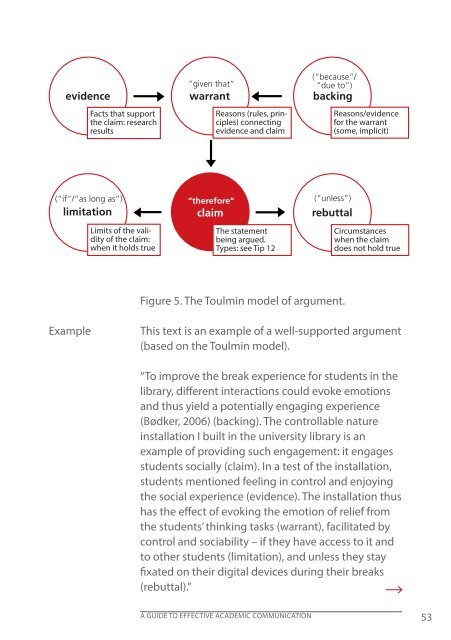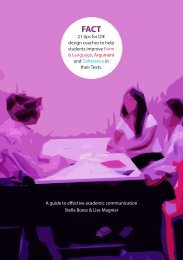Final Fact 18 march incl pics anders
Create successful ePaper yourself
Turn your PDF publications into a flip-book with our unique Google optimized e-Paper software.
evidence<br />
<strong>Fact</strong>s that support<br />
the claim: research<br />
results<br />
“given that“<br />
warrant<br />
Reasons (rules, principles)<br />
connecting<br />
evidence and claim<br />
(“because“/<br />
“due to“)<br />
backing<br />
Reasons/evidence<br />
for the warrant<br />
(some, implicit)<br />
(”if”/“as long as”)<br />
limitation<br />
Limits of the validity<br />
of the claim:<br />
when it holds true<br />
“therefore“<br />
claim<br />
The statement<br />
being argued.<br />
Types: see Tip 12<br />
(“unless”)<br />
rebuttal<br />
Circumstances<br />
when the claim<br />
does not hold true<br />
Figure 5. The Toulmin model of argument.<br />
Example<br />
This text is an example of a well-supported argument<br />
(based on the Toulmin model).<br />
“To improve the break experience for students in the<br />
library, different interactions could evoke emotions<br />
and thus yield a potentially engaging experience<br />
(Bødker, 2006) (backing). The controllable nature<br />
installation I built in the university library is an<br />
example of providing such engagement: it engages<br />
students socially (claim). In a test of the installation,<br />
students mentioned feeling in control and enjoying<br />
the social experience (evidence). The installation thus<br />
has the effect of evoking the emotion of relief from<br />
the students’ thinking tasks (warrant), facilitated by<br />
control and sociability – if they have access to it and<br />
to other students (limitation), and unless they stay<br />
fixated on their digital devices during their breaks<br />
(rebuttal).”<br />
A GUIDE TO EFFECTIVE ACADEMIC COMMUNICATION<br />
53



